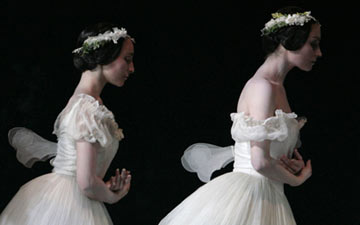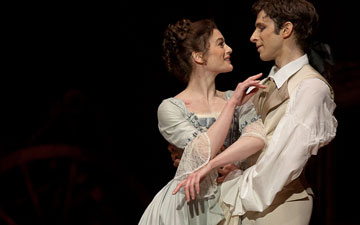
© Sebastien Mathé. (Click image for larger version)
Esprit de Corps – Paris Opera Ballet’s Giselle
Paris Opera Ballet
Giselle
New York, David H. Koch Theater
13 July 2012
www.operadeparis.fr
One of the curious things about the Giselle, which the Paris Opera Ballet is currently performing as part of its two-week Lincoln Center Festival run (until July 22), is that, though it was created in France in 1841, it was only performed there for a little over two decades before disappearing from the Paris stage. The original team included Théophile Gautier (who helped write the libretto), Adolphe Adam (who wrote the music), and the choreographers Jean Coralli and Jules Perrot. (Coralli was in charge of the group dances and Perrot was responsible for Giselle’s steps.) (1) It was in Russia that the ballet was preserved, and subsequently revived, by Marius Petipa. He of course made his own changes, mostly in the second act, which was expanded in order allow the wilis more opportunities to dance. (The wilis, of course, are the hellions who torment Albrecht and poor, unhappy Hilarion; inspired by Heine’s De l’Allemagne, they are the vengeful spirits of young women who perish before reaching the altar.) It was Petipa’s version, preserved in Stepanov notation by the ballet master, Nicholas Sergeyev, that was brought to the west by Diaghilev’s Ballets Russes in 1910, and subsequently staged, under Sergeyev’s direction, at the Paris Opera Ballet (in 1924) and elsewhere. Such are the vagaries of ballet history; each work is a continual work-in-process, reflecting layer upon layer of changes reflecting tastes, developments in technique, and the individual talents of particular dancers. There is really no such thing as an echt-Giselle, though Pacific Northwest Ballet recently undertook a fascinating restaging which took into account original documents from as far back as the 1840’s. (2)
The version being presented by the Paris Opera Ballet this week and next dates from 1991, when the ballet was restaged by Patrice Bart and Eugene Polyakov, both ballet masters with the company (Polyakov died in 1996). At the time, the setting was changed to evoke the Breton countryside, but, in 1998, the original Rhenish locale was restored, with sets and costumes reproducing those that Alexandre Benois had designed for the ballet in 1924. (Benois, a distinguished artist and art historian, became Diaghilev’s right hand man in the early days of the Ballets Russes, for whom he designed such ballets as Les Sylphides and Petrushka.) And so the wheel of history turns. It must be said, the Parisian sets and costumes are truly lovely, especially those of the second act. (The sets were recreated by Silvano Mattei.) More two-dimensional in appearance than those in other productions, and rendered in a faded palette, the sets are like pages in a story-book. There is nothing “real” about them, no great attempt to create the illusion of depth or perspective. This is a story, and the action upon the stage has the vividness of a place that exists only in the mind or in a book.
The costumes, realized by Claudie Gastine, are also beautiful, especially those for the wilis. Sumptuous, full, long skirts with layer upon layer of tulle so light it could fly off by itself; soft, ruched bodices with puffy sleeves and deep décolletés exposing miles of soft white flesh, tiny diaphanous wings and crowns of flowers for the hair. The arrival of the wilis takes one’s breath away. Not only are they individually beautiful, with their soft port-de-bras and milky-white shoulders, but they are all eerily the same, in every way: same size, same build – not skeletally thin, either – , same arms, same tilt of the head, same gaze, same feet. And they move as one, with precisely the same timing and quality of movement. I have never seen anything like it, not even the Shades scene I witnessed in Paris just a few months ago. The absolute synchronicity of movement, shape, and intention sent shivers up my spine. It was like a special effect in a movie: one person, multiplied by twenty-six. Uniformity is not something I usually look for, but on this night, it hit me: here lies the fascination of ballet, the thing it does so well. This is unity of style taken to a philosophical plane.
Partly for this reason, I was more taken with the second act of this production than with the first. Aurélie Dupont, on July 13, was an extremely comely Giselle, impeccable in every way, but slightly too knowing for my personal taste. In the first act, where the seduction takes place, she never really convinced me that she was a young girl, or that she was shy or excitable or frail. With her strong, womanly face and one sleeve drooping to reveal an eminently kissable shoulder, she came off more as a budding femme fatale only beginning to discover her power over men. Her dancing, too, did not have the sparkle or febrile quality of other Giselles of recent memory. Instead she offered a kind of regal repose, a clean, strong, articulate rendition of the choreography, and a dignified reserve. Her acting had the same qualities: understanding, clarity, and lack of excess. Giselle’s mad scene and death can be harrowing to behold. Dupont’s is restrained; the madness comes in stages. At first, she looks mostly sad, as any woman in her circumstances would. The only real sign that something is truly amiss is that she stands with her feet turned in; considering the extreme attention to correctness which is part of the French style, this is a monumental detail. Her grasping of Albrecht’s sword seems more like an act of despair and anger than the suicidal compulsion of a deranged mind. In the words of Gautier, hers was a “pretty death”. In the second act, Dupont’s restraint was more in tune with her not-quite-human state. Again, her interpretation was unencumbered with unnecessary detail or excesses of emotion. No tragic mask, no wild changes in tempo. I will say that the passage in which she slowly raised one leg to the side and then turned her body away from it so that she now appeared in profile, lowering her torso as the leg rose behind her, was sublime. I have never seen anyone execute this difficult transition completely smoothly, without tiny adjustments of the foot and leg. Hers was like silk.
Her Albrecht, Mathieu Ganio, looked as if he had just stepped out of a book of fairy tales: pale and dark-haired, with a high, noble forehead, pronounced cheekbones, and a proud, Gallic nose. It was hard to say which of the two, Ganio or Dupont, was the prettier. His acting was quietly unforced and utterly convincing, with an easy nobility that never tipped over into haughtiness. The seduction began as a game; as Giselle came out to look for the person who had just knocked on her door, he watched her from a distance, charmed by her demeanor, and then gently bumped her shoulder. The playful intimacy of this gesture came as a surprise. Soon he began to betray tenderness; it was clear that this village girl charmed him as no Lady in his court ever had. In the second act, his traversal of the stage to Giselle’s grave had a quiet gravity and poise one seldom sees in this scene. No dramatic cape fluttering, no theatrics. He suffered with grace. His dancing was refined and articulate, never forced. Line was never sacrificed for the sake of effect. His jumps were airy and soft, his legs forming beautiful pictures in the air as they beat together, producing a satisfying whack. Only in his desperate second-act solo – were Albrecht dances for his life – did Ganio fully release his technical bravura, with a series of entrechats sixes (jumps with the legs crossing in the air) that was both spectacular and spectacularly controlled. The jumps soared up and up, the feet sparkled, while his expression remained quietly plaintive, with no sign of strain or tension, and he slowly raised his hands to Myrtha, Queen of the Wilis, pleading for mercy. Even as he suffered, he was dignified and elegant.
Some final thoughts: Most productions of Giselle eliminate the scene in which a group of men play dice in the forest, just before the appearance of the wilis, but the French company has kept it, and I must say the sound of dice being thrown as the mist rolls in adds a pleasing eeriness to the scene. I found the acting of the nobles in Act I a bit stiff, with the exception of Vincent Cordier, in the role of the Prince of Courlande, whose haughtiness was deliciously over the top. Vincent Chaillet was an impeccable and likeable Hilarion, if a tad young-looking. And, in the peasant pas de deux – which in this version is cheerfully interspersed with dancing by Giselle’s friends – Charline Giezendanner jumped and turned with great charm and vivacity. (Her partner was less assured.) Talent abounds throughout the ranks. It may have taken the efforts of Petipa and Sergeyev to bring Giselle back to France, but now it’s clear it’s in good hands.
(1) This background owes much to Susan Au’s essay in the International Encyclopedia of dance, an invaluable resource.
(2) See ‘Giselle… Ballet’s Great Tragedy

















Last night I saw the Paris Opera Giselle. I am a former ballet student and a ballet lover. I have seen Giselle countless times by several ballet companies. I could observe some differences in both acts. The Russians, of course are the best; they do it perfectly in each and every aspect.
I have seen the Paris before several times, and I do like the company. I enjoyed very much the performance last night. Clairemarie Osta was the picture of innocence and purity in the first act. The madness scene was beyond sadness and expressions. The soloists (or stoiles) were good, not very exceptionals compared to the Russians, but the best part was the chorus and Myrtha, the Queen of the Wilis (Nolwenn Daniel). They all looked like real spirits with that drama and unity, that balance, that pure classic technique, that etherial and floating quality that made me feel the music and the Wilis running through my veins. They were breathtaking. The show was worth the price of the ticket. Thanks to all for the enjoyment I felt!